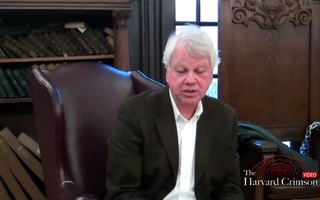The Abstract Expressionists claimed the canvas as a physical embodiment of their psyche and the Minimalists examined the relationship between the viewer and object. Roni Horn, in the three decades of work currently being shown at the Institute of Contemporary Art/Boston (ICA), attempts to reconcile the two. Horn, a Rhode Island School of Design and Yale University alumna, has been working as a visual artist since the 1970s, garnering critical acclaim, awards, and one-person exhibits at major institutions. Despite the immense body of work, range of time, and differing mediums that the mid-career retrospective includes, “Roni Horn aka Roni Horn” is cohesive in its examination of the ambiguity and contradictions of perception.
The ICA—with its waterfront location, glass and metal architecture, and massive windows streaming natural light—not only stands up to, but compliments the exhibit, holding its own against the Modernist juggernauts Tate Modern in London and Whitney Museum of American Art where “Roni Horn aka Roni Horn” had previously traveled. The building itself opened at the end of 2006—the first new art museum built in Boston in nearly 100 years.
In “Still Water (The River Thames, for Example),” the architectural space best enhances Horn’s work. Fifteen close-up color photographs of water encircle the room, and the ICA supplies a sixteenth image with its floor to ceiling view of the harbor. While this could be construed as distracting in some cases, this intrusion of the gallery space prods the viewer to notice the work’s dualities of motion and stillness, change and permanence, and similarity and difference in relation to the Boston Harbor.
With footnotes of Horn’s meditations on the images below each photograph, there is a repeated application of text in an unexpected medium. The footnotes call attention to three separate, but linked relationships: Horn and the photograph, Horn and the viewer, and the image and viewer.
Working out of the tradition of Minimalism, Horn’s work has traces of the movement—seriality, utilitarian materials, and austere simplicity and beauty. Perhaps some of the most Minimalist pieces in the exhibit, collectively called “White Dickinson,” six bars of cast aluminum and white plastic stand propped in a room evenly spaced from each other. Despite the solidity of the bars, this propping invokes fragility and impermanence, producing an enigma.
Like a piece by influential Minimalist Donald Judd, “White Dickinson” forces the viewer to recognize his relationship with the work, noticing the subtle changes in light and color depending on his position. But unlike Judd’s repeated metal rectangles, all of these bars are separate works, each a different height with a different Emily Dickinson quote embedded in the aluminum. By inserting language, Horn injects her own personality and thus her own hand, breaking the fabricator assembly, non-artistic touch, and industrial mold of Minimalism.
Horn has stripped away text, but still alludes to this discussion of artistic relationships, memory, and change through image and juxtaposition alone in her most recent piece, “a.k.a.” The work consists of pairs of framed photographs of the artist at various stages of her life. Like the photographs of the sea, each image is incredibly different despite being joined by the common denominator of subject matter—in this case, a frontal headshot of Horn.
Within each pair, the photographs contradict and complement one another. Horn, as a late adolescent blanketed with curly brown hair, is juxtaposed with Horn in her middle ages rendered androgynous with her grey crew cut. The composition of each of the photographs—Horn’s head tilted to opposite sides—produces a reflective quality; one image could be flipped across the vertical axis to cover the other. This mirror-like possibility literalizes the actual mirroring of subject matter. The similarity and differences within the pair are simultaneously stressed.
These pairs are repeated to form a set, leaving the viewer to decide how to engage them—as a whole or a succession of couplets—and thus reemphasizing the uniqueness of perception. By casting herself in these pairs for the viewer’s scrutiny, Horn establishes a double-fold relationship between her and the viewer, as well as the object and the viewer. Horn succeeds in rendering photography, which is automatically singular and permanent, multifaceted and ephemeral.
The ICA presents “Roni Horn aka Roni Horn” neither by time nor medium, fittingly letting the viewer traverse and experience the significant collection on his own. A progression in style can be detected between the earlier and more recent works, just as a unity in message can be grasped from the group. Horn spectacularly balances coherence and novelty even in three decades of her work,w while the ICA proves that it can handle such a major exhibition in its relatively new location and building.
—Staff writer Kristie T. La can be reached at kla@fas.harvard.edu.
Read more in Arts
MOBA Changes Trash to TreasureRecommended Articles
-
Crimson Sweeps Before Getting SweptAfter coming up short against Ivy League-leading Penn (16-4, 7-0) 3-1, the Harvard volleyball team (8-11, 4-4 Ivy League) sought to go over .500 in conference play when it took a two-game road trip against Brown (5-13, 1-6) and Yale (18-4, 6-1) this weekend.
-
 Split Marks Final Weekend
Split Marks Final Weekend -
 SEASON RECAP: Big League Wins Punctuate Season
SEASON RECAP: Big League Wins Punctuate Season -
 Bob Ryan Talks Harvard Basketball
Bob Ryan Talks Harvard Basketball -
Charity Concert Raises Funds for Victims of Floods and FamineOne World, a charity concert benefiting victims of famine in the Horn of Africa and of floods in Pakistan, was held in Memorial Church on Friday night.
-
Beethoven (\ b t, -v n\), ElectropopThe student electronic music group will give its debut performance at the Arts First festival.













